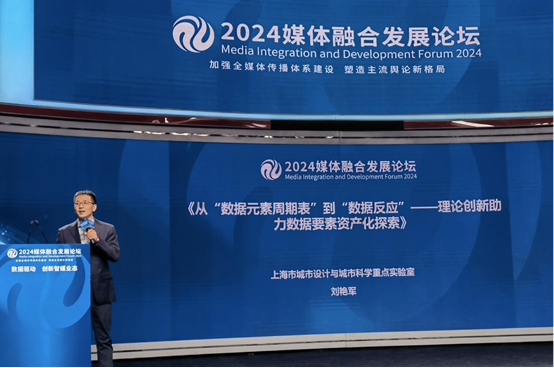"Periodic table of data elements" unveiled
Gold, copper, coal...Every type of mineral resource on Earth has a precise designation. Data, defined as the fifth production factor after land, labor, capital, and technology, is often metaphorically referred to as a new type of "mineral resource." However, up until recently, no organization has been able to directly specify what type of data "mineral resource" it possesses. New research is hoping to change that.
As the global digital economy accelerates, how to fully unleash the immense potential of data elements has become an urgent question. At the "2023 Digital Economy Summit" held in Shanghai in September, representatives from People's Daily Online and the State Key Laboratory of Communication Content Cognition publicly announced for the first time that the People's Data Research Institute (the digital economy think tank platform under People's Data) would collaborate with multiple partners. They plan to create a foundational theoretical framework that, similar to the periodic table of elements in the physical world, would enable the precise classification of data beyond industry or geographic limitations and simulate "chemical reactions" between different types of data. Following this, the Shanghai Key Laboratory of Urban Design and Urban Science (LOUD), an internationally leading team, joined this collaborative research project.
On Oct. 25, 2024, LOUD released its latest research findings, titled "From 'Periodic Table of Data Elements' to 'Data Reactions': Theoretical Innovations Supporting the Assetization of Data Elements".

Liu Yanjun, deputy executive director of the Shanghai Key Laboratory of Urban Design and Urban Science. (People's Daily Online/Weng Qiyu)
Liu Yanjun, deputy executive director of LOUD, explained that to truly unlock data's potential, a fundamental shift is needed from "big data applications" to "data element applications." Instead of simply collecting and analyzing data, it's essential to delve into the intrinsic value of data, transforming it into a core resource that can drive economic and social development. Additionally, data needs to transition from being a "resource" to an "asset," moving from closed, internal use to shared, collaborative use, allowing data to flow and generate greater social and economic benefits.
Currently, data transformation faces several obstacles, including inconsistent data quality, frequent data silos, and unclear application scenarios. These issues have become "stumbling blocks" that limit the potential of data elements.
Liu believes that the "periodic table of data elements" paves a new path for the systematic analysis and application of data.
The "periodic table of data elements," as its name suggests, breaks down data elements into fundamental units that are easier to understand and operate. Based on this concept, a data element identification system is being developed. This system labels data based on region, industry, volume, time, quality, update frequency, and other characteristics, creating a unique "identity code" that clearly identifies each data resource. Using these principles, circulating data can be linked with a unique code. This marks the first-phase achievement of developing the "periodic table of data elements".
With the clear identification of data elements, further analysis of "data reactions" is possible. Liu explained that just like atoms in the chemical periodic table, these elements can combine and interact in different ways to generate various complex data structures and application scenarios. By clearly identifying data elements and analyzing "data reactions," we can process and compute scattered, disordered data resources according to specific processing models, ultimately creating data element scenarios with practical application value.
"In simple terms, if the chemical reaction in the physical world is like oxygen and hydrogen combining under heat to produce water, then in the digital space, oxygen and hydrogen are our data elements, and the heating condition is the 'data reaction,'" Liu explained.
This research was unveiled at a parallel session of the Media Integration and Development Forum 2024 hosted by People's Daily and co-organized by People’s Daily Online and People's Daily Digital Communication Co., Ltd.
Photos
Related Stories
- China to boost financing support for data development, utilization
- China issues guidelines on accelerating development, utilization of data resources
- China issues regulations on network data security management
- SW China's Guizhou harnesses strong computing power to empower industries
- Pioneering data exchange in SW China reports surge in transactions, expands nationwide
Copyright © 2024 People's Daily Online. All Rights Reserved.









